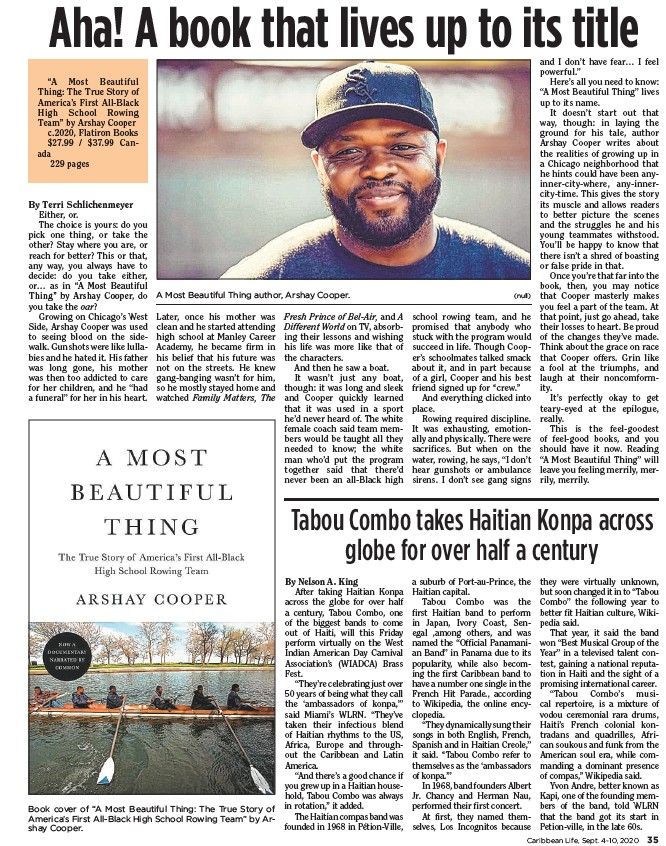
Aha! A book that lives up to its title
Tabou Combo takes Haitian Konpa across
globe for over half a century
Caribbean Life, Sept. 4-10, 2020 35
By Terri Schlichenmeyer
Either, or.
The choice is yours: do you
pick one thing, or take the
other? Stay where you are, or
reach for better? This or that,
any way, you always have to
decide: do you take either,
or… as in “A Most Beautiful
Thing” by Arshay Cooper, do
you take the oar?
Growing on Chicago’s West
Side, Arshay Cooper was used
to seeing blood on the sidewalk.
Gunshots were like lullabies
and he hated it. His father
was long gone, his mother
was then too addicted to care
for her children, and he “had
a funeral” for her in his heart.
Book cover of “A Most Beautiful Thing: The True Story of
America’s First All-Black High School Rowing Team” by Arshay
Cooper.
Later, once his mother was
clean and he started attending
high school at Manley Career
Academy, he became firm in
his belief that his future was
not on the streets. He knew
gang-banging wasn’t for him,
so he mostly stayed home and
watched Family Matters, The
Fresh Prince of Bel-Air, and A
Different World on TV, absorbing
their lessons and wishing
his life was more like that of
the characters.
And then he saw a boat.
It wasn’t just any boat,
though: it was long and sleek
and Cooper quickly learned
that it was used in a sport
he’d never heard of. The white
female coach said team members
would be taught all they
needed to know; the white
man who’d put the program
together said that there’d
never been an all-Black high
school rowing team, and he
promised that anybody who
stuck with the program would
succeed in life. Though Cooper’s
schoolmates talked smack
about it, and in part because
of a girl, Cooper and his best
friend signed up for “crew.”
And everything clicked into
place.
Rowing required discipline.
It was exhausting, emotionally
and physically. There were
sacrifices. But when on the
water, rowing, he says, “I don’t
hear gunshots or ambulance
sirens. I don’t see gang signs
and I don’t have fear… I feel
powerful.”
Here’s all you need to know:
“A Most Beautiful Thing” lives
up to its name.
It doesn’t start out that
way, though: in laying the
ground for his tale, author
Arshay Cooper writes about
the realities of growing up in
a Chicago neighborhood that
he hints could have been anyinner
city-where, any-innercity
time. This gives the story
its muscle and allows readers
to better picture the scenes
and the struggles he and his
young teammates withstood.
You’ll be happy to know that
there isn’t a shred of boasting
or false pride in that.
Once you’re that far into the
book, then, you may notice
that Cooper masterly makes
you feel a part of the team. At
that point, just go ahead, take
their losses to heart. Be proud
of the changes they’ve made.
Think about the grace on race
that Cooper offers. Grin like
a fool at the triumphs, and
laugh at their noncomformity.
It’s perfectly okay to get
teary-eyed at the epilogue,
really.
This is the feel-goodest
of feel-good books, and you
should have it now. Reading
“A Most Beautiful Thing” will
leave you feeling merrily, merrily,
merrily.
“A Most Beautiful
Thing: The True Story of
America’s First All-Black
High School Rowing
Team” by Arshay Cooper
c.2020, Flatiron Books
$27.99 / $37.99 Canada
229 pages
A Most Beautiful Thing author, Arshay Cooper. (null)
By Nelson A. King
After taking Haitian Konpa
across the globe for over half
a century, Tabou Combo, one
of the biggest bands to come
out of Haiti, will this Friday
perform virtually on the West
Indian American Day Carnival
Association’s (WIADCA) Brass
Fest.
“They’re celebrating just over
50 years of being what they call
the ‘ambassadors of konpa,’”
said Miami’s WLRN. “They’ve
taken their infectious blend
of Haitian rhythms to the US,
Africa, Europe and throughout
the Caribbean and Latin
America.
“And there’s a good chance if
you grew up in a Haitian household,
Tabou Combo was always
in rotation,” it added.
The Haitian compas band was
founded in 1968 in Pétion-Ville,
a suburb of Port-au-Prince, the
Haitian capital.
Tabou Combo was the
first Haitian band to perform
in Japan, Ivory Coast, Senegal
,among others, and was
named the “Official Panamanian
Band” in Panama due to its
popularity, while also becoming
the first Caribbean band to
have a number one single in the
French Hit Parade., according
to Wikipedia, the online encyclopedia.
“They dynamically sung their
songs in both English, French,
Spanish and in Haitian Creole,”
it said. “Tabou Combo refer to
themselves as the ‘ambassadors
of konpa.’”
In 1968, band founders Albert
Jr. Chancy and Herman Nau,
performed their first concert.
At first, they named themselves,
Los Incognitos because
they were virtually unknown,
but soon changed it in to “Tabou
Combo” the following year to
better fit Haitian culture, Wikipedia
said.
That year, it said the band
won “Best Musical Group of the
Year” in a televised talent contest,
gaining a national reputation
in Haiti and the sight of a
promising international career.
“Tabou Combo’s musical
repertoire, is a mixture of
vodou ceremonial rara drums,
Haiti’s French colonial kontradans
and quadrilles, African
soukous and funk from the
American soul era, while commanding
a dominant presence
of compas,” Wikipedia said.
Yvon Andre, better known as
Kapi, one of the founding members
of the band, told WLRN
that the band got its start in
Petion-ville, in the late 60s.